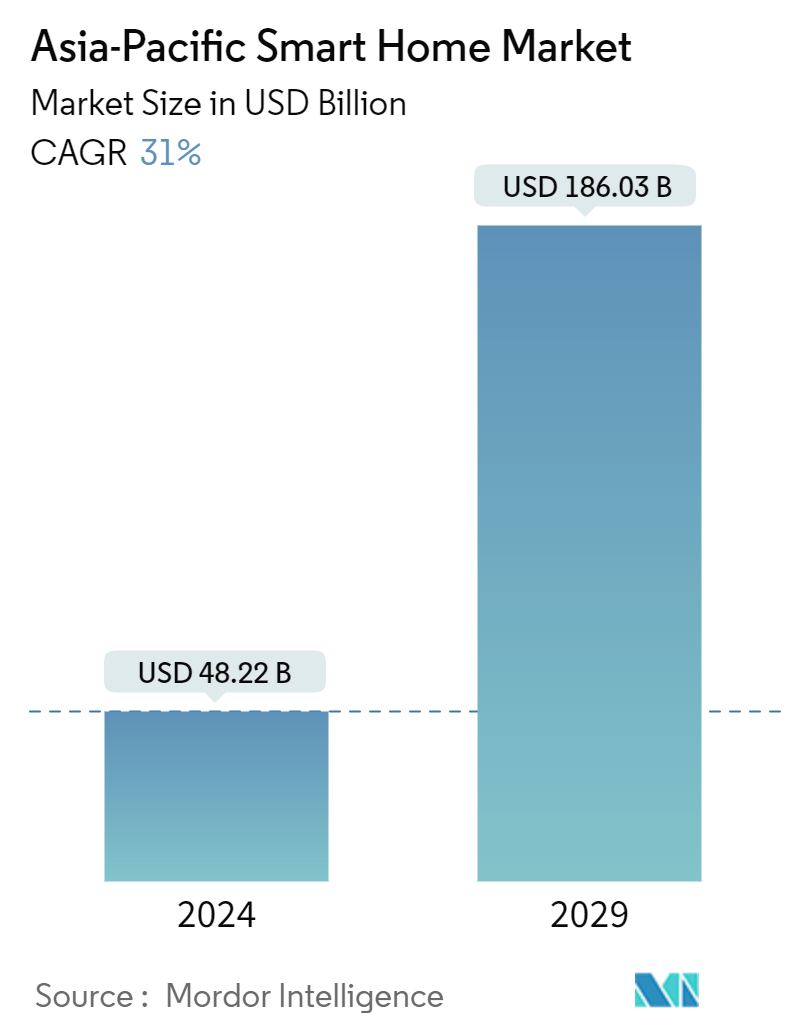Market Size of Asia-Pacific Smart Home Industry

| Study Period | 2019 - 2029 |
| Base Year For Estimation | 2023 |
| Market Size (2024) | USD 48.22 Billion |
| Market Size (2029) | USD 186.03 Billion |
| CAGR (2024 - 2029) | 31.00 % |
| Market Concentration | Low |
Major Players
*Disclaimer: Major Players sorted in no particular order |
Asia-Pacific Smart Home Market Analysis
The Asia-Pacific Smart Home Market size is estimated at USD 48.22 billion in 2024, and is expected to reach USD 186.03 billion by 2029, growing at a CAGR of 31% during the forecast period (2024-2029).
- Home automation and smart homes broadly describe various monitoring solutions, controls, and automated functions. While basic home automation can include anything from motor-operated garage doors to automated security systems, smart home systems involve a web portal or smartphone application as the user interface to interact with a computerized system.
- Key drivers of this surge include the rising adoption of smartphones, expanding online business presence, and heightened government initiatives aimed at digitalizing economies. The GSMA's 2023 report, "The Mobile Economy for Asia Pacific," highlights the region's pioneering 5G markets, with countries like Australia, Japan, Singapore, and South Korea embracing 5G as a mainstream technology.
- Moreover, India stands out as one of the fastest-growing 5G markets, projected to add tens of millions of 5G connections in 2023 alone. The region is anticipated to boast approximately 1.4 billion 5G connections by 2030, representing 41% of all mobile connections.
- Asia-Pacific has also witnessed a consistent rise in unique mobile subscribers. As per GSMA forecasts, the region will see an addition of nearly 400 million new subscribers over the next seven years. South Asia, in particular, commands about two-thirds of the region's total mobile subscriber base, and it's expected to continue leading in new subscriber additions through 2030. This surge in smartphone popularity has, in turn, fueled a boom in mobile application development. Leveraging this trend, households increasingly integrate their smartphones with electronic devices to create temporary networks, especially for smart home automation.
- The smart HVACR (heating, ventilation, air conditioning, and refrigeration) systems concern the house's environmental controls. They comprise smart thermites, sensors, control valves, smart actuators, air conditioning systems, and smart room heaters. Across the region, due to the increasing government regulations across developed and developing countries, most of the new buildings need more competent heating and cooling systems, augmenting the growth of HVAC systems and the market.
- Also, integrating artificial intelligence and machine learning is revolutionizing the interaction between smart home products. AI and ML enable smart home products to display relevant content based on the weather, time of day, and other contextual factors. This allows for a more personalized and engaging experience for viewers. The rollout of 5G networks and the Internet of Things (IoT) is expected to create more demand in the market.
Asia-Pacific Smart Home Industry Segmentation
A smart home refers to integrated and networked devices that automate different functions within a home and can communicate with each other, as well as a centralized control interface. The prominent purpose of this type of system is to enhance comfort, safety, energy efficiency, and management of household resources.
The Asia-Pacific smart home market is segmented by product type (comfort and lighting, control and connectivity, energy management, home entertainment, security, smart appliances, and HVAC control), technology (Wi-Fi, Bluetooth, and other technologies), and country (China, Japan, India, South Korea, and Rest of Asia-Pacific). The market sizes and forecasts are provided in terms of value (USD) for all the above segments.
| By Product Type | |
| Comfort and Lighting | |
| Control and Connectivity | |
| Energy Management | |
| Home Entertainment | |
| Security | |
| Smart Appliances | |
| HVAC Control |
| By Technology | |
| Wi-Fi | |
| Bluetooth | |
| Other Technologies |
| By Country*** | |
| China | |
| Japan | |
| India | |
| South Korea | |
| Australia and New Zealand |
Asia-Pacific Smart Home Market Size Summary
The Asia-Pacific smart home market is experiencing significant growth, driven by the increasing adoption of smartphones, the expansion of online business presence, and government initiatives aimed at digitalizing economies. The region's advancement in 5G technology, particularly in countries like Australia, Japan, Singapore, and South Korea, is facilitating the integration of smart home systems, which utilize web portals and smartphone applications for user interaction. The rise in unique mobile subscribers, especially in South Asia, is further propelling the market as households increasingly integrate smartphones with electronic devices for home automation. The demand for smart HVAC systems is also on the rise, fueled by global warming and the booming construction sector, which necessitates more efficient heating and cooling solutions. The integration of artificial intelligence and machine learning is enhancing the functionality of smart home products, offering personalized experiences and driving market expansion.
In China, the concept of smart homes is gaining traction as consumers embrace a variety of smart devices, from door locks to intelligent vacuum robots. The country's strategic public-private partnerships and technological innovations have facilitated the implementation of smart city infrastructure, extending its influence to residential areas. The market is characterized by a fragmented landscape with numerous small and large players, including major companies like Schneider Electric SE, Emerson Electric Corporation, ABB Ltd, Honeywell International Inc., and Siemens AG. These companies are focusing on expanding their global consumer base through collaborations, partnerships, and acquisitions. Recent developments, such as Haier Smart Home Co. Ltd's acquisition of Carrier Global Corporation's commercial refrigeration business and Rinnai Australia's acquisition of iZone, highlight the industry's move towards environmental sustainability and enhanced smart home solutions. The introduction of new connectivity standards and AI-driven systems further underscores the dynamic nature of the market, offering consumers greater flexibility and integration options.
Asia-Pacific Smart Home Market Size - Table of Contents
-
1. MARKET INSIGHTS
-
1.1 Market Overview
-
1.2 Industry Value Chain Analysis
-
1.3 Industry Attractiveness - Porter's Five Forces Analysis
-
1.3.1 Bargaining Power of Suppliers
-
1.3.2 Bargaining Power of Consumers
-
1.3.3 Threat of New Entrants
-
1.3.4 Threat of Substitute Products
-
1.3.5 Intensity of Competitive Rivalry
-
-
1.4 Technology Snapshot
-
1.5 Impact of COVID-19 Aftereffects and Other Macroeconomic Factors on the Market
-
-
2. MARKET SEGMENTATION
-
2.1 By Product Type
-
2.1.1 Comfort and Lighting
-
2.1.2 Control and Connectivity
-
2.1.3 Energy Management
-
2.1.4 Home Entertainment
-
2.1.5 Security
-
2.1.6 Smart Appliances
-
2.1.7 HVAC Control
-
-
2.2 By Technology
-
2.2.1 Wi-Fi
-
2.2.2 Bluetooth
-
2.2.3 Other Technologies
-
-
2.3 By Country***
-
2.3.1 China
-
2.3.2 Japan
-
2.3.3 India
-
2.3.4 South Korea
-
2.3.5 Australia and New Zealand
-
-
Asia-Pacific Smart Home Market Size FAQs
How big is the Asia-Pacific Smart Home Market?
The Asia-Pacific Smart Home Market size is expected to reach USD 48.22 billion in 2024 and grow at a CAGR of 31% to reach USD 186.03 billion by 2029.
What is the current Asia-Pacific Smart Home Market size?
In 2024, the Asia-Pacific Smart Home Market size is expected to reach USD 48.22 billion.

